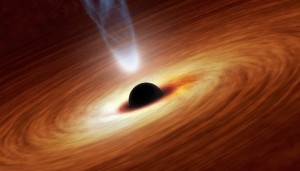Seeing a Black Hole’s Gravitational Vortex
New observations solve a 30-year-old puzzle of mysterious signals from around black holes.
Strange things happen around black holes, especially spinning ones. Their strong gravitational pull means they don’t just pull in gas to munch on — they drag the very fabric of spacetime around them as they spin.
Every rotating massive body does this — even puny Earth, as measured by the Gravity Probe B. But around black holes the so-called frame-dragging effect (also known as the Lense-Thirring effect) is particularly strong. Like flies stuck in honey, anything embedded in that spacetime will get dragged along, too. And now, with new observations from the XMM-Newton and NuSTAR space telescopes, astronomers have connected the effect to long-mysterious signals seen around stellar-mass black holes.
Black Hole Beats

This artist's impression depicts an accretion disk surrounding a black hole. The black hole drags spacetime with it as it spins. So X-ray-emitting plasma near the black hole, stuck in spacetime like a fly stuck in honey, precesses. The X-rays strike matter in the surrounding disk, making it to glow like a fluorescent bulb. The glow appears to rotate around the accretion disc to the right (top), to the front (middle), and to the left (bottom).
ESA / ATG medialab
ESA / ATG medialab
While we can’t see black holes directly, we can see those that are guzzling gas. Such meals are easy to come by for black holes in binary systems, as they pull mass from their unlucky companion stars. As the gas spirals inward, it heats up: the closer it comes to the black hole, the hotter the gas will be, and the higher the frequency of the photons it radiates. Very near the black hole, the plasma reaches a fevered pitch, puffing up and emitting energetic X-rays.
Back in the 1980s, astronomers started seeing signals amidst these flickering X-rays that looked suspiciously regular. Dubbed quasi-periodic oscillations, these QPOs seemed to come from something whizzing intriguingly close-in around the black hole. More than a decade later, an idea emerged: astronomers could be witnessing the frame dragging effect in action.
Here’s the general picture: hot puffed-up plasma very near the black hole radiates X-rays. Some of these X-rays hit the surrounding gas disk, knocking electrons off of iron atoms in the swirling gas. As those iron atoms snatch back their electrons, they fluoresce, emitting X-rays at a specific energy.
The whole system — the black hole, the hot inner plasma, and the surrounding disk — is spinning like a top. And if the disk is tilted relative to the black hole, then the top will wobble, or precess. We’ll see the hot plasma fluoresce off of part of the outer disk, and that fluorescence will appear to rotate around the black hole. When we’re seeing a part of the disk spinning around toward Earth, we’ll see its iron emission blueshifted; emission from a part of the disk spinning away again will shift redward.
Adam Ingram (University of Amsterdam, The Netherlands) and colleagues set out to observe this effect directly. They pointed the XMM-Newton and NuSTAR space telescopes at the system known as H1743-322, where a black hole with a mass of about 10 Suns is drawing in gas from its companion star. Four of the five observations clearly show the iron line shifting back and forth in the spectrum over the course of 4 to 5 seconds, exactly in the way that the frame-dragging effect predicts.
“This is a very intriguing result,” says Laura Brenneman (Harvard-Smithsonian Center for Astrophysics), who was not involved with the study. “Certain types of QPOs in X-ray[-emitting black hole] binaries have long been suspected to arise from some form of precession, but this result is the closest thing I've seen to hard evidence for that.”
This result turns stellar-mass black holes into a proving ground for new physics. “If you can get to the bottom of the astrophysics, then you can really test general relativity,” Ingram said in NASA’s press release, welcome news to physicists who are searching for a deeper theory of gravity.
One of These Is Not Like the Others
Over 3 days’ worth of exposure, XMM-Newton collected five sets of data. While four of these matched beautifully, one, known as orbit 1b, didn’t conform at all to expectations. It could simply be that some gas obstructed the astronomers’ view, or it could be that the observation is telling astronomers something more fundamental.
“I am curious as to what is going on in XMM-Newton’s orbit 1b that is so anomalous compared to the others,” Brenneman adds, “but I don't think it diminishes the result at all, just adds an extra dimension and opens up more questions.”
Another intriguing aspect of QPOs is that they’ve (almost) never been seen in the supermassive variety of black holes. These active galactic nuclei (AGN) guzzle gas at the center of galaxies with the same setup as stellar-mass black holes: a black hole, a gas disk, and X-ray-emitting plasma. The only thing they’re missing is the binary companion star.
“There has only been one reputable claim of a QPO in an AGN back in 2008, and it hasn't been seen again since,” Brenneman says. “If there were QPOs-a-plenty in AGN, we would likely have detected them by now.” Why they aren’t there, no one knows.
With one mystery solved, it’s clear there are still more cases awaiting closure.

No comments:
Post a Comment